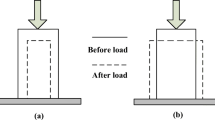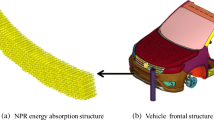Abstract
Weight has a significant effect on the mobile performance of a robot. A coal mine rescue robot (CMRR) is a special type of mobile robot and is relatively heavy because it is explosion proof. In this study, a simple optimization method is proposed for the design of a lightweight, explosion-proof housing of a CMRR. A stress analysis of the individual panels is performed first and ANSYS software is used to perform a stress analysis of multiple stiffened panels. A simple stress equation is developed based on the results and represents the basis of the optimization method. Subsequently, the optimization equations of the explosion-proof housing are developed and the explosion-proof housing of the CUMT-IV robot is designed. Explosion tests were conducted using a physical prototype to verify the strength of the explosion-proof housing. Further, two simple guidelines are developed based on the optimized results to reduce the design difficulty for engineering applications. The simple optimization method proved suitable for designing the explosion-proof housing.










Similar content being viewed by others
References
Morris A, Ferguson D, Omohundro Z, Bradley D, Silver D, Baker C, Thayer S, Whittaker C, Whittaker W (2006) Recent developments in subterranean robotics. J Field Robot 23(1):35–57
Wang W, Dong W, Su Y, Wu D, Du Z (2014) Development of search-and-rescue robots for underground coal mine applications. J Field Robot 31(3):386–407
Zhao J, Gao J, Zhao F, Liu Y (2017) A search-and-rescue robot system for remotely sensing the underground coal mine environment. Sensors 17(10):2426–2448
Li YT, Zhu H, Li MG, Li P (2016) A novel explosion-proof walking system: twin dual-motor drive tracked units for coal mine rescue robots. J Cent South Univ 23(10):2570–2577
Reddy AH, Kalyan B, Murthy CSN (2015) Mine rescue robot system—a review. Proc Earth Planet Sci 11:457–462
Dohare YS, Maity T, Das PS, Paul PS (2015) Wireless communication and environment monitoring in underground coal mines—review. IETE Tech Rev 32(2):140–150
Ma X, Zhu H (2016) Gas concentration prediction based on the measured data of a coal mine rescue robot. J Robot 3:1–10
Li YW, Ge SR, Zhu H (2009) Design and manufacture of flameproof enclosure of coal mine rescue robot. Coal Mine Mach 30(2):104–106
Zhou D, Zhang J, Song Z (2009) Modeling and finite element analysis of flameproof enclosure of coal mine mobile robot. Coal Mine Mach 33(6):84–86
Krause T, Bewersdorff J, Markus D (2017) Investigations of static and dynamic stresses of flameproof enclosures. J Loss Prev Process Ind 49:775–784
Sun Y, Liu L (2015) Optimization design of complex flameproof enclosure based on finite element analysis. Ind Mine Autom 41(4):52–54
Zhao JC, Hou YL, Liu JJ, Gao P (2015) Flame-proof enclosure hydraulic pressure test analysis of underground electrical equipment. Coal Mine Mach 36(4):102–104
Jang S, Goh CH, Choi HJ (2015) Multiphase design exploration method for lightweight structural design: example of vehicle mounted antenna-supporting structure. Int J Precis Eng Manuf Green Technol 2(3):281–287
Toledo R, Aznárez JJ, Greiner D, Maeso O (2016) Shape design optimization of road acoustic barriers featuring top-edge devices by using genetic algorithms and boundary elements. Eng Anal Boundary Elem 63:49–60
Wang C, Zhao M, Ge T (2016) Structural topology optimization with design-dependent pressure loads. Struct Multidiscipl Optim 53(5):1005–1018
GB 3836.2-2010 (2011) Explosive atmospheres—part 2: equipment protection by flameproof enclosures “d”. China Standard Press, Beijing
Xu MC, Soares CG (2012) Numerical assessment of experiments on the ultimate strength of stiffened panels. Eng Struct 45(2284):460–471
Wang Y, Wharton JA, Shenoi RA (2015) Ultimate strength assessment of steel stiffened plate structures with grooving corrosion damage. Eng Struct 94:29–42
An Y, Wang C, Cui H (2016) Design of thinner and lighter explosion proof housing for coal mine flameproof electrical equipment. Colliery Mech Electr Technol 1:38–40
Acknowledgments
The project is supported by the National High Technology Research and Development Program of China (863 Program) (Grant No. 2012AA041504) and the Priority Academic Program Development of Jiangsu Higher Education Institutions (PAPD), China.
Author information
Authors and Affiliations
Corresponding author
Additional information
Technical Editor: Victor Juliano De Negri.
Rights and permissions
About this article
Cite this article
Li, Y., Zhu, H. A simple optimization method for the design of a lightweight, explosion-proof housing for a coal mine rescue robot. J Braz. Soc. Mech. Sci. Eng. 40, 340 (2018). https://doi.org/10.1007/s40430-018-1264-8
Received:
Accepted:
Published:
DOI: https://doi.org/10.1007/s40430-018-1264-8




